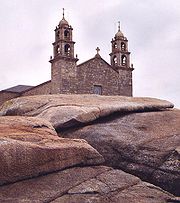
Pedras de abalar
Encyclopedia

Galician language
Galician is a language of the Western Ibero-Romance branch, spoken in Galicia, an autonomous community located in northwestern Spain, where it is co-official with Castilian Spanish, as well as in border zones of the neighbouring territories of Asturias and Castile and León.Modern Galician and...
for "oscillating stones", are several large stones that can easily be moved by a person or the wind in Galicia, Spain. There are many versions found throughout the world; in English these are called rocking stone
Rocking stone
Rocking stones are large stones that are so finely balanced that the application of just a small force causes them to rock. They are found throughout the world. Some are man-made megaliths, but others are natural, often left by glaciers.Logan or rocking stones are known in Scotland sometimes as...
s, or logan stones.
One of these is in Muxia
Muxia
Muxia is a coastal town in the province of A Coruña, in Galicia, Spain. It is one of the final destinations for pilgrims on the Way of St. James after visiting the shrine of the apostle Saint James the Great in Santiago de Compostela.Muxia is known for its spectacular beaches...
, the "Pedra da Barca". These are large stones that are balanced on a point, so that they can be moved back and forth easily, or even wiggle in response to the wind. These were used at one time to determine the guilt or innocence of those accused of serious crimes.
Other pedra de abalar include the "Pena da Conga" in Melide, and the "Castro do Faro" in O Porriño
O Porriño
O Porriño is a municipality in Galicia, Spain in the province of Pontevedra.It is an industrial town, in the metropolitan area of Vigo, of which it is an important economic dependency. One of its main industries is granite production...
.
Pedras de Abalar in Galicia:
- BaionaBaiona, PontevedraBaiona is a municipality in Galicia, Spain, in the province of Pontevedra.Baiona is a tourist town with a medieval historical center situated by the outlet of the Vigo Bay. Its population of just over 11,000 rises to around 45,000 in the summer, if one includes tourists...
Island - Corbelle (VilalbaVilalbaVilalba, is a municipality in Galicia , specifically in the province of Lugo.- Journalistic Tradition :Villalba had during the 20th century a rich journalistic tradition that began in 1902 with the Ideal Villalbés, a newspaper handwritten by the poet and journalist Antonio García Hermida...
) - Sande (OurenseOurenseOurense is a city in northwestern Spain, the capital of the province of the same name in Galicia. Its population of 108,674 accounts for 30% of the population of the province and makes it the third largest city of Galicia.-Population:...
) - Paradela (near CambadosCambadosCambados is a municipality in Galicia, Spain in the province of Pontevedra. It is known for its famous white wine, Albariño.- Culture :Fishing is a major industry in this coastal area of Galicia...
) - Pedra da Barca (near MuxiaMuxiaMuxia is a coastal town in the province of A Coruña, in Galicia, Spain. It is one of the final destinations for pilgrims on the Way of St. James after visiting the shrine of the apostle Saint James the Great in Santiago de Compostela.Muxia is known for its spectacular beaches...
) - Meixide (Viana do BoloViana do BoloViana do Bolo is a large municipality in Ourense in the Galicia region of north-west Spain. It's located in the south-east of the province.-External links:**...
) - Villamayor de Boullosa (in the Limia RiverLimia RiverThe Limia River is a river in Galicia, Spain, and Portugal, with an extension of 108 km.The source of the Limia is Talariño Mountain , close to the Paradiña village in the Sarreaus municipality...
region) - Pena da Conga (Melide)
- Castro do Faro (O PorriñoO PorriñoO Porriño is a municipality in Galicia, Spain in the province of Pontevedra.It is an industrial town, in the metropolitan area of Vigo, of which it is an important economic dependency. One of its main industries is granite production...
) - Pena de Embade de Ferrol (demolished, 1755)

